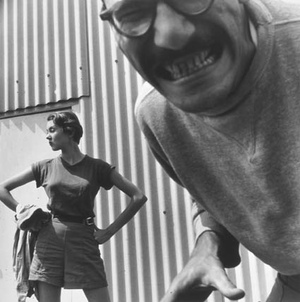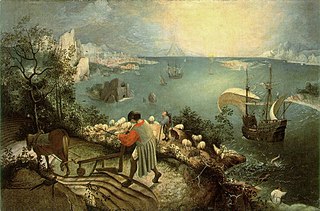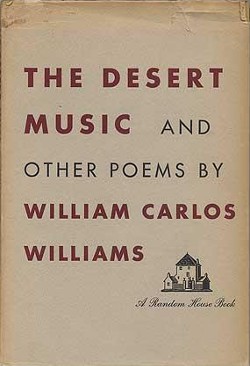
William Carlos Williams was an American poet and physician of Latin American descent closely associated with modernism and imagism. His Spring and All (1923) was written in the wake of T. S. Eliot's The Waste Land (1922). In his five-volume poem Paterson (1946–1958), he took Paterson, New Jersey as "my 'case' to work up. It called for a poetry such as I did not know, it was my duty to discover or make such a context on the 'thought.'" Some of his best known poems, "This Is Just To Say" and "The Red Wheelbarrow", are reflections on the everyday. Other poems reflect the influence of the visual arts. He, in turn, influenced the visual arts; his poem "The Great Figure" inspired the painting I Saw the Figure 5 in Gold by Charles Demuth. Williams won a posthumous Pulitzer Prize for Poetry for Pictures from Brueghel and Other Poems (1962).

Asphodelus is a genus of mainly perennial flowering plants in the asphodel family Asphodelaceae that was first described by Carl Linnaeus in 1753. The genus was formerly included in the lily family (Liliaceae). The genus is native to temperate Europe, the Mediterranean, Africa, the Middle East, and the Indian Subcontinent, and some species have been introduced to, and are now naturalized in, other places such as New Zealand, Australia, Mexico and southwestern United States. Many asphodels are popular garden plants, which grow in well-drained soils with abundant natural light.

Kenneth Charles Marion Rexroth was an American poet, translator, and critical essayist. He is regarded as a central figure in the San Francisco Renaissance, and paved the groundwork for the movement. Although he did not consider himself to be a Beat poet, and disliked the association, he was dubbed the "Father of the Beats" by Time magazine. Largely self-educated, Rexroth learned several languages and translated poems from Chinese, French, Spanish, and Japanese.

Louis Zukofsky was an American poet. He was the primary instigator and theorist of the so-called "Objectivist" poets, a short lived collective of poets who after several decades of obscurity would reemerge around 1960 and become a significant influence on subsequent generations of poets in America and abroad.

Carl Rakosi was the last surviving member of the Objectivist poets, still publishing and performing poetry well into his 90s.

Harold Hart Crane was an American poet. Inspired by the Romantics and his fellow Modernists, Crane wrote highly stylized poetry, often noted for its complexity. His collection White Buildings (1926), featuring "Chaplinesque", "At Melville's Tomb", "Repose of Rivers" and "Voyages", helped to cement his place in the avant-garde literary scene of the time. The long poem The Bridge (1930) is an epic inspired by the Brooklyn Bridge.

Roy Fisher was an English poet and jazz pianist. His poetry shows an openness to both European and American modernist influences, whilst remaining grounded in the experience of living in the English Midlands. Fisher has experimented with a wide range of styles throughout his long career, largely working outside of the mainstream of post-war British poetry. He has been admired by poets and critics as diverse as Donald Davie, Eric Mottram, Marjorie Perloff, Sean O’Brien, Peter Robinson, Mario Petrucci and Gael Turnbull.
The Desert Music is a work of music for voices and orchestra composed by the minimalist composer Steve Reich. It is based on texts by William Carlos Williams and takes its title from the poetry anthology The Desert Music and Other Poems. The composition consists of five movements, with a duration of about 46 minutes. In both its arrangement of thematic material and use of tempi, the piece is in a characteristic arch form (ABCBA). The piece was composed in 1983 and had its world premiere on 17 March 1984 in Cologne, Germany.
Ann Fisher-Wirth is an American poet and scholar, based at the University of Mississippi. She has won several teaching awards, including Liberal Arts Outstanding Teacher of the Year (2006), Humanities Teacher of the Year (2007), and the Elsie M. Hood Award (2014). Her poetry has received numerous awards, including several Pushcart nominations and a Pushcart Special Mention.

Pictures from Brueghel and Other Poems is a 1962 book of poems by the American modernist poet/writer William Carlos Williams. It was Williams's final book, for which he posthumously won the Pulitzer Prize for Poetry in 1963. Two previously-published collections of poetry are included: The Desert Music and Other Poems from 1954 and Journey to Love from 1955.

William Bronk was an American poet. For his book, Life Supports (1981), he won the National Book Award for Poetry.

Joel Lester Oppenheimer was an American poet associated with both the Black Mountain poets and the New York School. He was the first director of the St. Marks Poetry Project (1966–68). Though a poet, Oppenheimer was perhaps better known for his columns in the Village Voice from 1969 to 1984.

"Landscape with the Fall of Icarus" is an ecphrastic poem by the 20th-century American poet William Carlos Williams that was written in response to Landscape with the Fall of Icarus, traditionally attributed to Pieter Bruegel. Williams first published the poem as part of a sequence in The Hudson Review in 1960, subsequently using the sequence as the basis for his final book, Pictures from Brueghel and Other Poems, published in 1962.
Richard G. Swift was an American composer and music theorist.

Al Que Quiere! is a collection of 52 poems by William Carlos Williams, published in 1917 by the Four Seas Company of Boston, Massachusetts. Williams paid $50 to the publisher. The original edition announces, "Many of the poems in this book have appeared in magazines, especially in Poetry, Others, The Egoist, and The Poetry Journal."

The Desert Music and Other Poems was a 1954 Random House book collecting 1949-54 poems by the American modernist poet/writer William Carlos Williams. It is now collected, along with Pictures from Brueghel and Other Poems (1962) and Journey to Love (1955), in the New Directions paperback Pictures from Brueghel and other poems by William Carlos Williams: Collected Poems 1950-1962.

"Asphodel, That Greeny Flower" is a poem by American poet William Carlos Williams. It was published in 1955 as part of Williams's anthology Journey to Love.
Triadic-line poetry or stepped line is a long line which "unfolds into three descending and indented parts". Created by William Carlos Williams, it was his "solution to the problem of modern verse" and later was also taken up by poets Charles Tomlinson and Thom Gunn.

The Wedge is a 1944 book of poems by American modernist writer and poet William Carlos Williams. He assembled this collection in response to requests from American servicemen during World War II for a pocket-sized collection of his work to take into deployment with them. Despite the poet's inquiries and the nature of the requests that prompted him to approach them, several publishers rejected The Wedge. Their grounds for doing so were a perceived lack of literary quality and wartime shortages. The book was eventually handset printed by Henry Duncan and Wightman Williams at Cummington Press and bound surreptitiously on the premises and at the expense of one of the publishers who had previously rejected it. The book is dedicated to poet Louis Zukofsky, who helped Williams revise and rearrange the poems for publication.















